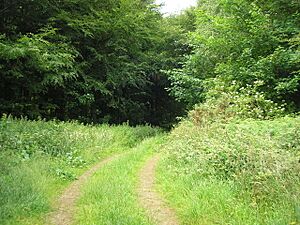Helen Hope facts for kids
Helen Hope (born 1677, died 1768) was an amazing Scottish woman who loved planting trees. She became the Countess of Haddington when she married. Helen is famous for planting huge forests in a place called Haddingtonshire, especially a big forest known as Binning Wood.
Helen's Early Life
Helen Hope was born in a town called Kirkliston, Scotland. Her parents were Lady Margaret Hamilton and John Hope. She was baptized, which is like a special naming ceremony, on September 28, 1677. Helen had a younger brother named Charles, who was born in 1681. Charles later became an important person in government and even helped run the Bank of Scotland.
When Helen was only five years old, something very sad happened. Her father drowned while traveling with a royal family member, the Duke of York. This Duke later became King James VII of Scotland. In 1696, when Helen was older, her mother arranged for her to marry her first cousin, Thomas Hamilton. He was the Earl of Haddington, and when they married, Helen became the Countess of Haddington.
Planting Trees: Helen's Big Project
Helen and her husband first lived in a place called Leslie House. There, they had their first child, a son named Charles. He was given the special title of Lord Binning from birth. Charles grew up to be a politician, which means he helped make laws and run the country.
In 1700, Helen's family moved to Tyninghame House. This was her husband's family home in Haddingtonshire. Helen immediately had a big idea: she wanted to plant lots of trees! At first, her husband and the local people weren't very interested.
But Helen was determined. She decided to plant trees on the open, empty land around Tyninghame. She named this new forest Binning Wood, to honor her son, Lord Binning. This huge area, about 800 acres (which is like 600 football fields!), was filled with 50 different kinds of trees. Helen also designed a wild, natural area and a bowling green. From the bowling green, 14 different walking paths began. Her husband, who later became very proud of her work, even wrote a book about planting trees!
Helen's Legacy
Helen Hope passed away in Edinburgh on April 19, 1768, when she was 90 years old. She was buried next to her husband in Tyninghame. Years later, in 1856, a tall stone monument called an obelisk was built. It honors Helen and her husband for all the amazing tree planting they did.
During the 1940s, a lot of Binning Wood was cut down. This was part of the war effort, as wood was needed for many things. Most of the wood was hardwood, like oak and beech trees. Some of the beechwood was even used to build parts for de Havilland Mosquito fighter planes!
After the war, the forest was replanted. This project took until 1960 to finish. The new trees were mostly Scots pine because hardwood trees were hard to find. The Earl of Haddington made sure the new forest was planted exactly like Helen's original design from 1707. Italian prisoners of war helped with the planting. Today, part of Binning Wood is used as a special place for "green funerals," where people can be buried in a natural way.


